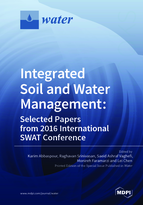Integrated Soil and Water Management: Selected Papers from 2016 International SWAT Conference
A special issue of Water (ISSN 2073-4441).
Deadline for manuscript submissions: closed (31 May 2017) | Viewed by 210886
Special Issue Editors
Interests: watershed modeling; calibration/uncertainty analysis; large-scale simulations; climate/landuse change impact studies; development of system tools
Interests: computational modeling of hydrology; water quality and spatial sciences problems; development and worldwide application of the SWAT model
Special Issues, Collections and Topics in MDPI journals
Interests: climate change; watershed modeling; model development; drought/flood analysis; dam operation optimization; landuse change impact analysis
Interests: watershed modeling; water resources management; hydrology; crop modeling; climate change analysis
Special Issues, Collections and Topics in MDPI journals
Interests: simulation and control of non-point-source pollution; water environment simulation and repair
Special Issues, Collections and Topics in MDPI journals
Special Issue Information
Dear Colleagues,
Soil and water are two key life-susstaining resources on Earth. If not protected, both elements will become humanity’s worst nightmares. Uncontrolable water flows, polluted water, and lack of water on the one hand, and infertile soils, polluted soils, duststorms, and topsoil erosion, on the other hand, can wreak havoc on human life and threaten its very existance. Ensuing dangers from climate change and populatoin growth will further strain these resources. To stop a nighmare scenario from happening, our only way is to manage these prized resources. Modeling programs, such as SWAT, are valuable tools in finding ways of combating food and water insecurity, and mitigating the impact of climate change and growing demands of resources. This Special Issue of Water is designed to show the results of analyses of scientists from all over the world in dealing with various environmental problems. The papers here are selected from the works presented at the 16th International SWAT conference held in Beijng. The information and analyses are intended to contribute to the development and implementation of effective soil and water manegement programs.
Dr. Karim Abbaspour
Prof. Dr. Raghavan Srinivasan
Dr. Saeid Ashraf Vaghefi
Dr. Monireh Faramarzi
Dr. Lei Chen
Guest Editor
Manuscript Submission Information
Manuscripts should be submitted online at www.mdpi.com by registering and logging in to this website. Once you are registered, click here to go to the submission form. Manuscripts can be submitted until the deadline. All submissions that pass pre-check are peer-reviewed. Accepted papers will be published continuously in the journal (as soon as accepted) and will be listed together on the special issue website. Research articles, review articles as well as short communications are invited. For planned papers, a title and short abstract (about 100 words) can be sent to the Editorial Office for announcement on this website.
Submitted manuscripts should not have been published previously, nor be under consideration for publication elsewhere (except conference proceedings papers). All manuscripts are thoroughly refereed through a single-blind peer-review process. A guide for authors and other relevant information for submission of manuscripts is available on the Instructions for Authors page. Water is an international peer-reviewed open access semimonthly journal published by MDPI.
Please visit the Instructions for Authors page before submitting a manuscript. The Article Processing Charge (APC) for publication in this open access journal is 2600 CHF (Swiss Francs). Submitted papers should be well formatted and use good English. Authors may use MDPI's English editing service prior to publication or during author revisions.
Keywords
- Climate change impact
- Watershed management
- Modeling, Calibration/Uncertainty
- Water balance
- Conservation practices
- Water quality
- Large-scale modeling









